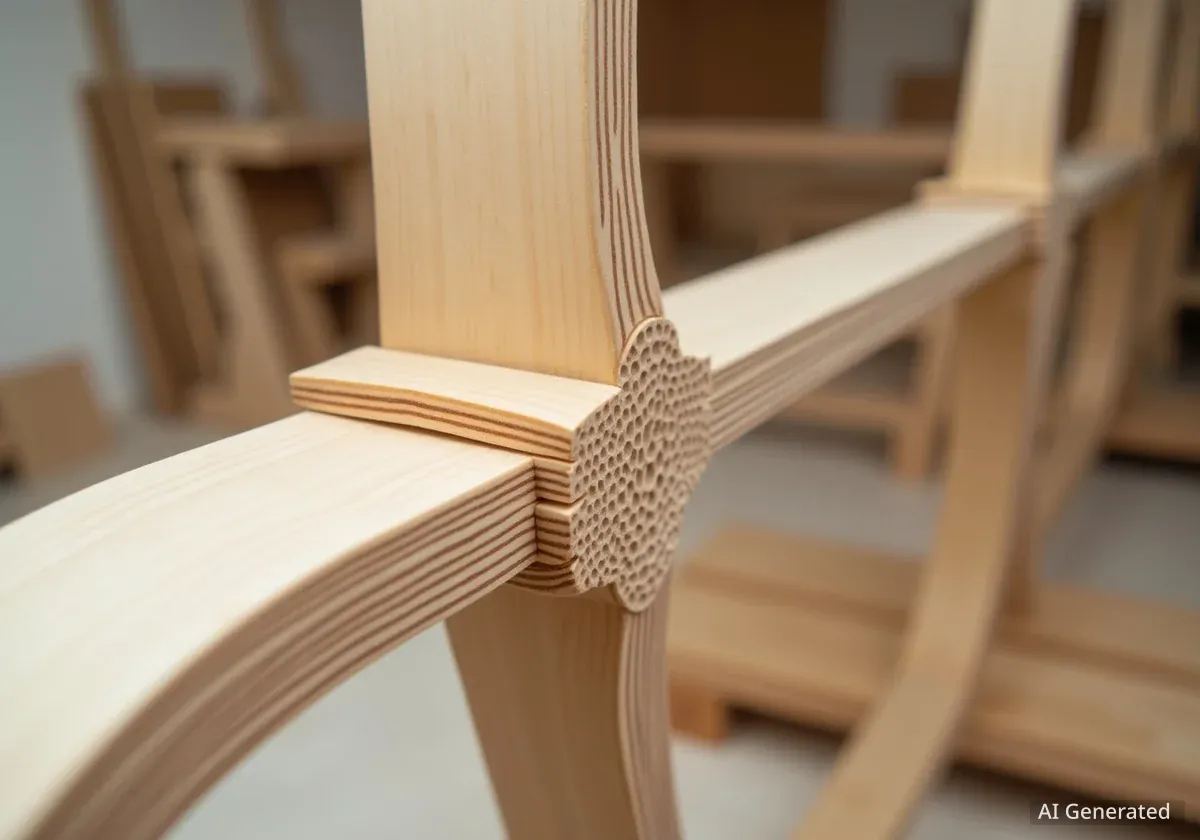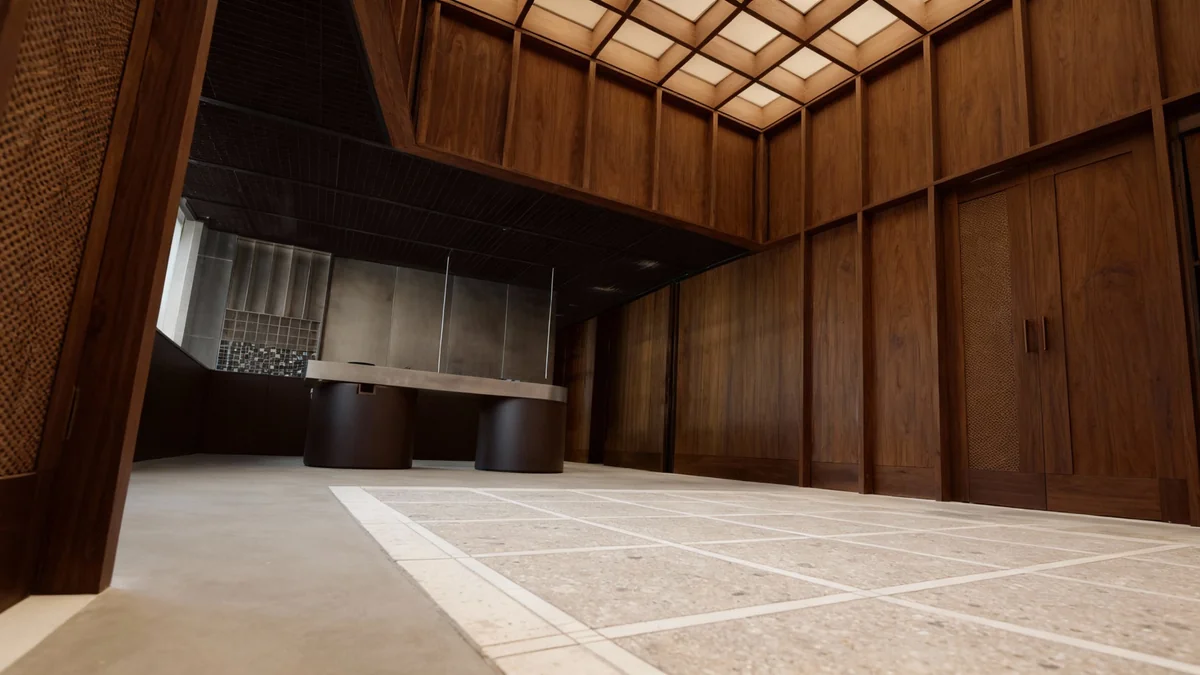The CINTRE project, developed by Baptiste Marx during his Master of Industrial Design at ENSCI in France, introduces an innovative approach to structural connections. This design utilizes bent plywood elements as integrated connectors, aiming to simplify assembly and reduce the need for separate hardware. Marx's background in composite materials project management significantly influences this experimental design philosophy.
Key Takeaways
- Baptiste Marx's CINTRE project proposes bent plywood as structural connectors.
- The design emphasizes material and manufacturing processes.
- It aims for a multidisciplinary approach combining aesthetics and technical aspects.
- The project explores adaptable structures using heat-reforming capabilities of plywood.
Innovative Material-Based Design
Baptiste Marx's design philosophy centers on contextualized object creation. He focuses on how materials and manufacturing processes shape the final aesthetic and function of a product. The CINTRE project exemplifies this approach by using plywood as both the structural component and the connection element.
Marx states,
"I base my practice on contextualized object design. Sensitive to an aesthetic resulting from materials and manufacturing processes, I favor an experimental and reflective approach, where research occupies a central place. Between sensitive and technical creations, I seek to develop a multidisciplinary and conscious design."This quote highlights his commitment to integrating material properties directly into the design process.
The core idea involves bending plywood pieces to form the necessary angles and joints. This eliminates the need for external metal connectors or complex fastening systems. The process requires precision in bending, especially for angled components that must match the main structural pipes.
Challenges and Practical Considerations
While the CINTRE project offers an intriguing concept, practical challenges exist. Creating consistently bent pieces, particularly those with specific angles and concave sections for pipe integration, would likely require specialized jigs or forms. This suggests a need for controlled manufacturing environments rather than on-site improvisation.
Fact: Plywood Properties
Plywood is a material made from thin layers of wood veneer glued together, with adjacent layers having their wood grain rotated up to 90 degrees. This construction improves strength and reduces warping, making it suitable for bending when properly treated.
One argument against this design is its potential lack of flexibility compared to systems using straight poles and separate connectors. Once a piece of plywood is bent into a specific joint, its use becomes fixed for that particular structural configuration. This limits adaptability if the design needs to change.
However, proponents suggest that in situations where straight, long poles are not readily available, smaller, pre-bent pieces might be more accessible. The ability to re-bend the same piece with heat could also offer a degree of reusability, though this would require further testing.
Material Unification and Emergency Applications
A notable aspect of the CINTRE project is its use of a single material, plywood, for both the main structure and the connectors. This material unification can simplify logistics and potentially reduce waste in manufacturing. In certain emergency scenarios, where resources are limited, having a single adaptable material could prove advantageous.
Context: Industrial Design Education
Master's programs in industrial design often encourage experimental approaches to materials and manufacturing. Students explore new ways to create products, focusing on sustainability, user experience, and innovative production techniques. Baptiste Marx's project fits within this tradition of pushing design boundaries.
The initial concept might suggest the use of zip ties for final assembly. However, this raises questions about the long-term durability and structural integrity. Substituting zip ties with easily sourced, strong rope could be a more practical and robust solution for temporary or emergency structures. This modification would align with the spirit of adapting available resources.
Design Philosophy and Future Potential
Marx's work reflects a broader trend in design education towards interdisciplinary thinking. His background in composite materials informs his ability to analyze and manipulate material properties for design solutions. The CINTRE project is not just about creating a new type of connector; it is about demonstrating a design methodology.
The emphasis on an experimental and reflective approach means that the project serves as a foundation for further research. Exploring the limits of plywood's bending capabilities, developing efficient bending jigs, and testing various fastening methods (beyond zip ties) would be natural next steps. The potential for this system to create lightweight, temporary structures is significant, especially in contexts where traditional construction materials are scarce.
The project aligns with the idea of conscious design, where every material choice and manufacturing step is considered for its environmental and practical implications. By reducing the number of different components and materials, the CINTRE system could contribute to more sustainable building practices in specific applications.
Challenges of Precision and Assembly
One of the most significant challenges for the CINTRE system lies in achieving precise angles and consistent bends for the connectors. For a stable structure, all connecting pieces must be bent to the exact required angles. This often necessitates specialized equipment and molds, known as jigs, to ensure uniformity and accuracy across multiple components.
Without such precision, the overall structural integrity could be compromised. The concave areas designed to cradle the main pipes also require careful shaping. This level of detail suggests that while the concept is simple, its execution for large-scale or robust applications would demand advanced manufacturing techniques.
Furthermore, the assembly process itself, if relying on bent plywood joints, would need to be straightforward. The ease of connecting these pieces, perhaps with a simple locking mechanism or a method to secure them firmly, would be critical for practical use. The choice of fasteners, whether rope or more permanent solutions, greatly influences the system's strength and reusability.
Comparison to Traditional Methods
Traditional construction often uses standardized straight elements combined with separate connectors, typically made of metal or rigid plastic. This approach offers high flexibility, allowing designers to create various structures from a common set of components. If a design needs to change, components can often be reconfigured or reused in different arrangements.
The CINTRE project, by contrast, integrates the connector directly into the structural element through bending. This creates a more monolithic component but reduces the modularity inherent in traditional systems. While this may simplify the bill of materials, it could also lead to more waste if a specific bent piece cannot be repurposed for a different structure.
The project highlights a fundamental tension in design: the desire for material purity and simplified component lists versus the need for flexibility and broad applicability. For certain niche applications, such as temporary shelters or specialized artistic installations, the CINTRE method could be highly effective. For more general-purpose construction, the adaptability of separate components might remain superior.
- Material Efficiency: Using one material for structure and connectors.
- Aesthetic Integration: Connectors become part of the visual design.
- Potential for Heat Reforming: Plywood can be re-bent with heat, offering some reusability.
- Precision Requirements: Accurate bending demands specialized tools and jigs.
- Fastener Choice: Simple rope might be more practical than zip ties for robust connections.
The CINTRE project by Baptiste Marx stands as an example of thoughtful industrial design. It pushes boundaries by challenging conventional notions of structural connections. While practical implementation presents specific challenges, the underlying philosophy of material-driven, conscious design offers valuable insights for future innovation in architecture and product development.




